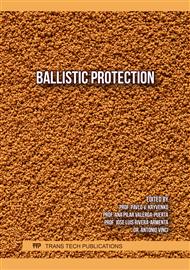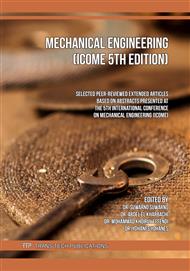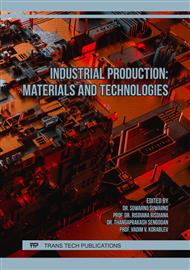[1]
S. Citation, Testing of Body Armor Materials: Phase III. 2012.
Google Scholar
[2]
Z. Cai, X. Huang, Y. Xia, G. Li, and Z. Fan, "Study on behind Helmet Blunt Trauma Caused by High-Speed Bullet," Appl. Bionics Biomech., vol. 2020, 2020.
DOI: 10.1155/2020/2348064
Google Scholar
[3]
D. J. Carr, I. Horsfall, and C. Malbon, "Is behind armour blunt trauma a real threat to users of body armour? A systematic review," J. R. Army Med. Corps, vol. 162, no. 1, p.8–11, 2016.
DOI: 10.1136/jramc-2013-000161
Google Scholar
[4]
L. Cannon, "Behind armour blunt trauma--an emerging problem.," J. R. Army Med. Corps, vol. 147, no. 1, p.87–96, 2001.
DOI: 10.1136/jramc-147-01-09
Google Scholar
[5]
C. R. Bass et al., "Injury risk in behind armor blunt thoracic trauma," Int. J. Occup. Saf. Ergon., vol. 12, no. 4, p.429–442, 2006.
DOI: 10.1080/10803548.2006.11076702
Google Scholar
[6]
R. L. Mabry et al., "United States Army Rangers in Somalia: an analysis of combat casualties on an urban battlefield.," J. Trauma, vol. 49, no. 3, p.515–519, Sep. 2000.
DOI: 10.1097/00005373-200009000-00021
Google Scholar
[7]
M. Muster, A. Hameed, and D. Wood, "Ricochet quantification using a multiple sensor approach," Def. Technol., vol. 17, no. 2, p.305–314, 2021.
DOI: 10.1016/j.dt.2020.02.017
Google Scholar
[8]
G. Guo, S. Alam, and L. D. Peel, "Numerical analysis of ballistic impact performance of two ceramic-based armor structures," Compos. Part C Open Access, vol. 3, no. July, p.100061, 2020.
DOI: 10.1016/j.jcomc.2020.100061
Google Scholar
[9]
R. T. Tang and H. M. Wen, "Predicting the perforation of ceramic-faced light armors subjected to projectile impact," Int. J. Impact Eng., vol. 102, p.55–61, Apr. 2017.
DOI: 10.1016/j.ijimpeng.2016.11.008
Google Scholar
[10]
D. B. Rahbek, J. W. Simons, B. B. Johnsen, T. Kobayashi, and D. A. Shockey, "Effect of composite covering on ballistic fracture damage development in ceramic plates," Int. J. Impact Eng., vol. 99, p.58–68, 2017.
DOI: 10.1016/j.ijimpeng.2016.09.010
Google Scholar
[11]
G. H. Yoon, J. S. Mo, K. H. Kim, C. H. Yoon, and N. H. Lim, "Investigation of bullet penetration in ballistic gelatin via finite element simulation and experiment," J. Mech. Sci. Technol., vol. 29, no. 9, p.3747–3759, 2015.
DOI: 10.1007/s12206-015-0821-7
Google Scholar
[12]
C. Stone, F. M. Windsor, M. Munday, and I. Durance, "Natural or synthetic – how global trends in textile usage threaten freshwater environments," Sci. Total Environ., vol. 718, p.134689, 2020.
DOI: 10.1016/j.scitotenv.2019.134689
Google Scholar
[13]
K. Goda, M. S. Sreekala, A. Gomes, T. Kaji, and J. Ohgi, "Improvement of plant based natural fibers for toughening green composites-Effect of load application during mercerization of ramie fibers," Compos. Part A Appl. Sci. Manuf., vol. 37, no. 12, p.2213–2220, Dec. 2006.
DOI: 10.1016/j.compositesa.2005.12.014
Google Scholar
[14]
A. F. H. Mukhammad, Murni, Mujiyono, D. Nurhadiyanto, S. A. Hassan, and T. W. B. Riyadi, "Preliminary study of fragment simulating projectile on epoxy-ramie composite," J. Phys. Conf. Ser., vol. 1446, no. 1, 2020.
DOI: 10.1088/1742-6596/1446/1/012001
Google Scholar
[15]
Sutikno, A. Safaat, and K. H. S. Fendy, "Natural Fiber Reinforced Composites as Bulletproof Panel Materials," Key Eng. Mater., vol. 867, p.82–90, 2020.
DOI: 10.4028/www.scientific.net/KEM.867.82
Google Scholar
[16]
M. Ravid, S. R. Bodner, and I. Holcman, "Analysis of very high-speed impact," Int. J. Eng. Sci., vol. 25, no. 4, p.473–482, Jan. 1987.
DOI: 10.1016/0020-7225(87)90073-5
Google Scholar
[17]
E. Liscio and R. Imran, "Angle of impact determination from bullet holes in a metal surface," 2020.
DOI: 10.1016/j.forsciint.2020.110504
Google Scholar
[18]
S. Abrate, "Modeling of impacts on composite structures," Compos. Struct., vol. 51, no. 2, p.129–138, 2001.
DOI: 10.1016/S0263-8223(00)00138-0
Google Scholar
[19]
J. Wiley, T. Avenue, and N. York, "Selection and Application Guidelines," vol. 01, no. May, p.10158, 1999.
Google Scholar
[20]
T. Covered, "Silicon Carbide (SiC) Propertie and Application," p.1–2, 2001.
Google Scholar




